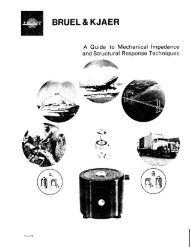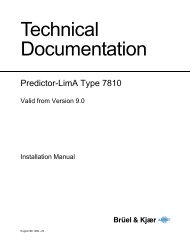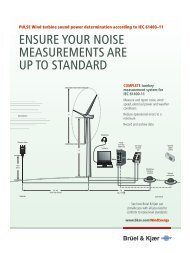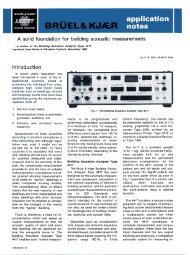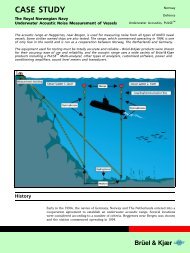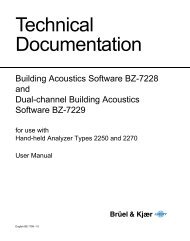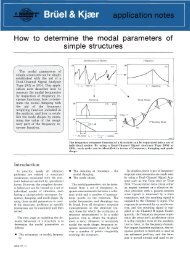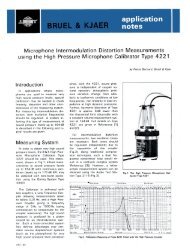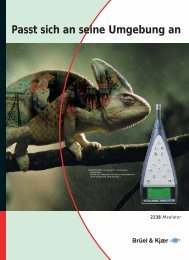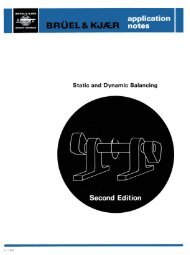4. Architectural (N).pub - Brüel & Kjær
4. Architectural (N).pub - Brüel & Kjær
4. Architectural (N).pub - Brüel & Kjær
Create successful ePaper yourself
Turn your PDF publications into a flip-book with our unique Google optimized e-Paper software.
SOUND, VIBRATION, EDUCATION<br />
Sound and speech are important<br />
parts of human life and culture.<br />
In classrooms, meeting rooms,<br />
cinemas, theatres, concert halls,<br />
etc. the design has to be such that<br />
it is easy to speak and comfortable<br />
to listen with a high degree of<br />
intelligibility. These issues of<br />
sound and vibration belong to the<br />
professional area of a specialist in<br />
architectural acoustics.<br />
Architects, interior designers and engineers<br />
have a responsibility to design<br />
functional and safe environments. It is<br />
very difficult, if not impossible, to meet<br />
these goals without considering acoustics.<br />
Acoustics are essential to the functioning<br />
of almost every type of architectural<br />
environment, from open offices to<br />
ARCHITECTURAL<br />
centres of worship. Some environments<br />
can even become dangerously loud and<br />
unsafe for the occupants.<br />
Engineers are working with sound and<br />
vibration attenuation in buildings and<br />
the sound quality in theatres, schools,<br />
cinemas and other large rooms where<br />
speech must be received clearly and<br />
intelligible and where music must be<br />
received undistorted over the entire<br />
area. Also important is the proper<br />
acoustic design of work areas in order<br />
to obtain a suitably low noise level.<br />
Building Acoustics<br />
Building Acoustics is the assessment of<br />
sound insulation in buildings and building<br />
elements. The acoustics of buildings<br />
are important for the well-being of people<br />
in their homes, workplace or <strong>pub</strong>lic<br />
ACOUSTICS<br />
venues and minimum standards are set<br />
in the building regulations of each country.<br />
Whether in private homes, at work,<br />
or at leisure, human lives are constantly<br />
affected by an ever increasing number<br />
of noise sources; televisions, kitchen<br />
appliances, neighbours, traffic, industry.<br />
<strong>Architectural</strong> acoustics<br />
is concerned with:<br />
• Building acoustics – sound transmission<br />
in buildings, effects of new<br />
building materials<br />
• Room acoustics – room design,<br />
speech intelligibility, sound reproduction<br />
in rooms, sound quality<br />
• Mechanical equipment noise
Sound, Vibration, Education<br />
Acoustical measurements are used to improve room acoustics in existing buildings<br />
predicting the effects of changes, and to predict and optimise the room acoustics<br />
of planned buildings.<br />
One method of reducing the pollution is<br />
to reduce the noise source level. However,<br />
building acoustics takes another<br />
approach and examines insulation and<br />
isolation from the source. Building<br />
acoustic measurements are used to<br />
validate new constructions and to troubleshoot<br />
existing ones. They are invaluable<br />
when designing or examining noise<br />
control constructions in buildings. Minimum<br />
requirements are set in the building<br />
regulations of each country and<br />
proper measurements should fulfil relevant<br />
standards such as ISO 140.<br />
Mechanical Equipment Noise<br />
Mechanical systems that serve the<br />
building are sources of noise and vibra-<br />
2<br />
Sound<br />
Source<br />
tion, both internally and externally.<br />
Ventilation, transformers, heating etc.<br />
are increasingly posing challenges for<br />
mechanical and structural engineers. In<br />
many countries tighter regulations and<br />
more demanding specifications are creating<br />
challenging conditions for adequate<br />
noise and vibration control.<br />
Sound power has become the preferred<br />
quantity to measure when determining<br />
equipment noise emissions. It is an absolute<br />
quantity, dependent only on the<br />
noise source itself, and independent of<br />
the acoustic environment. Noise emissions<br />
can be controlled with treatments<br />
such as insulation, noise barrier<br />
screens, low-noise fan blades etc.<br />
Processing<br />
Unit<br />
Receiver<br />
Room Acoustics<br />
The way sound is created, propagated,<br />
perceived, measured and modelled inside<br />
an enclosed space, is called Room<br />
Acoustics. The enclosed spaces can be<br />
dwellings, offices, workshops, factory<br />
halls, lecture rooms, auditoria, concert<br />
halls, transportation terminals etc. The<br />
acoustic measurements are used to<br />
validate new constructions and to troubleshoot<br />
existing ones. Reverberation<br />
Time is the single most important parameter<br />
used to describe Room Acoustics,<br />
but in addition, parameters describing<br />
music quality and speech intelligibility<br />
are important too.<br />
Testing Enclosures<br />
Often basic acoustic conditions are<br />
simulated in rooms or enclosures like<br />
anechoic chambers or reverberation<br />
rooms. An anechoic chamber is a<br />
shielded enclosure designed to suppress<br />
internal sound reflections. The boundaries<br />
absorb nearly all the incident<br />
sound, thereby, creating essentially<br />
free-field conditions. A reverberation<br />
room has hard boundaries and long<br />
reverberation time, and is especially<br />
designed to make the sound field inside<br />
it as diffuse (homogeneous) as possible.<br />
It can be used for measuring sound<br />
power and sound absorption coefficients.<br />
When checking sound insulation in actual<br />
buildings (field or in situ situations),<br />
the results are often influenced<br />
by flanking transmission. In field measurements,<br />
there may also be trouble<br />
accessing the site, time constraints or<br />
background noise.<br />
For checking constructions such as windows,<br />
floors and walls, laboratories use<br />
test suites consisting of two adjoining<br />
rooms. The test sample is mounted in a<br />
test opening between the two rooms.<br />
The two rooms are designed to elimi-<br />
Investigating the acoustical<br />
properties of a room,<br />
a simple clapping of hands<br />
and listening to the response<br />
of the room, may give<br />
a first impression.<br />
Although it may not be easy<br />
to describe accurately what is<br />
heard, this method gives<br />
an indication of whether music<br />
would sound pleasant<br />
or speech would be intelligible<br />
<strong>Brüel</strong> & <strong>Kjær</strong>
ROOM ACOUSTIC PARAMETERS<br />
There are a large number of acoustical parameters for<br />
rooms. Their purpose is to describe subjective sound impressions<br />
in an objective manner. All room acoustical parameters<br />
can be determined from the room impulse response.<br />
The room impulse response is the acoustic answer<br />
of a room excited by a short bang, a Dirac impulse.<br />
Some basic Room Acoustic Parameters are:<br />
• Early Decay Time (EDT)<br />
The EDT parameter is the reverberation time, measured<br />
over the first 10 dB of the decay.<br />
• Definition or Deutlichkeit (D50)<br />
The D50 parameter is the early to total sound energy<br />
ratio. It is a measure of the intelligibility of a speaker. It<br />
indicates how well a speaker can be understood by a<br />
listener in a particular seat of an auditorium.<br />
• Clarity or Klarheitsmass (C50)<br />
The parameter of Clarity is the early to late arriving<br />
sound energy ratio. It is a measure of the clarity of music.<br />
It is used for large rooms like chamber music and<br />
concert halls.<br />
nate the influence of flanking transmission<br />
– sound that propagates through<br />
any path other than the test opening -<br />
and background noise. This ensures that<br />
the results truly reflect the sound reduction<br />
of the sample.<br />
The noise levels in the two rooms under<br />
investigation are measured and subtracted,<br />
and the level difference is corrected<br />
for the influence of the reverberation<br />
time and background noise<br />
level in the receiving room. The measurements<br />
and calculations are made in<br />
1/1 or 1/3-octave bands and averaged<br />
over a number of positions in the<br />
rooms. Finally a single-number index is<br />
calculated by averaging over all the<br />
frequency bands.<br />
Basic Measurements<br />
The basic architectural acoustic measurements<br />
that should be dealt with are<br />
sound insulation, sound absorption,<br />
reverberation time and sound distribution.<br />
These measurements will demonstrate<br />
the effect of room size and<br />
shape, and acoustic absorption of the<br />
walls floors and ceilings on the sound<br />
environment as well as the ability of<br />
various constructions to attenuate noise<br />
from one room to another. General<br />
noise and vibration measurements are<br />
important because our houses and<br />
buildings contain ever increasing numbers<br />
of noise producing installations,<br />
and ways must be found to attenuate<br />
their sound emission.<br />
Soundproofing<br />
Soundproofing is any<br />
means of reducing<br />
the intensity of<br />
sound with respect<br />
to a specified source<br />
and receiver. There<br />
are several basic<br />
approaches to reducing<br />
sound: increasing<br />
the distance<br />
between the source<br />
and receiver; using<br />
noise barriers to<br />
block or absorb the<br />
energy of the sound<br />
waves, using damping<br />
structures such<br />
as sound baffles; or<br />
using active antinoise<br />
sound generators.<br />
Soundproofing affects<br />
sound in two<br />
different ways:<br />
sound reduction and<br />
sound absorption.<br />
Sound reduction<br />
simply blocks the<br />
passage of sound<br />
waves through the<br />
use of distance and<br />
intervening objects<br />
in the sound path.<br />
Sound absorption<br />
involves suppressing<br />
echoes, reverberation,<br />
resonance and<br />
<strong>Architectural</strong> Acoustics<br />
Stage parameters or support parameters (ST), in a variety<br />
of versions, describe the ensemble conditions or the energy<br />
fold back to the musicians on stage. They describe<br />
the ratio between the energy of the reflections and the<br />
energy of the direct sound.<br />
• Early Support Early (ST1 or STearly)<br />
The early reflected energy level relative to the initial<br />
energy measured at 1.0 m from an omni-directional<br />
source. It is commonly used to describe the degree of<br />
the musicians’ mutual hearing.<br />
• Late Support (STlate)<br />
The late reflected energy level relative to the initial<br />
measured at 1.0m from an omni-directional source. It<br />
describes the degree to which the musician hears the<br />
late reverberant sound.<br />
• Total Support (STtotal)<br />
Total Support describes the support from the room to<br />
the musicians own instrument.<br />
Some acoustical parameters are used for rating the understanding<br />
of speech, among these the Speech Transmission<br />
Index, STI, and the Percentage Articulation Loss of Consonants,<br />
%Alcons.<br />
The acoustical properties of every seat in a concert<br />
hall may be measured and mapped to ensure the<br />
best<br />
<strong>Brüel</strong> & <strong>Kjær</strong> 3
Sound, Vibration, Education<br />
reflection. The damping characteristics<br />
of the materials in the room are important<br />
in sound absorption.<br />
Sound Absorption<br />
It is also important that a student be<br />
familiar with the measurement of the<br />
acoustic absorption coefficient of materials,<br />
as absorbing materials find widespread<br />
use where noise or sound levels<br />
have to be regulated. For small samples<br />
of the material this coefficient can be<br />
found by means of the Standing Wave<br />
Apparatus. For measurement on bigger<br />
samples a different method is used. The<br />
change in reverberation time of a room<br />
is measured when a part of a wall in the<br />
room is covered with the material under<br />
investigation.<br />
Sound Insulation<br />
Sound energy does not remain in the<br />
room where it is produced, but propa-<br />
4<br />
gates throughout the building by any<br />
available path, intruding into other<br />
rooms as noise. Each country has its<br />
own standards of sound insulation in<br />
buildings, but it is basically measured in<br />
the same way all over the world.<br />
Buildings are constructed using many<br />
elements, and the sound insulation may<br />
be compromised by defects in materials<br />
or workmanship. Quite often, the traditional<br />
measurement will show that the<br />
sound insulation is not as good as expected<br />
or required by law. If this is the<br />
case, a measurement using sound intensity<br />
can diagnose the fault by showing<br />
the contribution of each surface<br />
element to the sound reduction index. If<br />
a certain weak area is suspected, the<br />
contribution for that area can be measured<br />
and checked separately. Or the<br />
partition can be divided into smaller<br />
sections and each section checked until<br />
the fault is found. This measurement<br />
Sound source and microphone positions<br />
for measuring airborne sound insulation:<br />
L1 = Source room level<br />
L2 = Receiving room level<br />
B2 = Background level<br />
T2 = Reverberation Time<br />
method also eliminates flanking transmission<br />
(or, by subtraction, provides an<br />
estimate of its influence), and is ideal<br />
for detecting and measuring the influence<br />
of leaks.<br />
Facade Sound Insulation<br />
Facade sound insulation is measured<br />
like sound insulation between rooms,<br />
except that one "room" is open space.<br />
The sound level is measured inside the<br />
Sound pressure levels are used to<br />
meausre and calculate the sound<br />
insulation of building facades.<br />
When measuring sound pressure outside<br />
and inside a facade simultaniously 2channel<br />
measurements are required as the<br />
sound level varies over time.<br />
<strong>Brüel</strong> & <strong>Kjær</strong>
eceiving room and outside the façade<br />
of the building. The level difference is<br />
then corrected for the influence of the<br />
reverberation time and background<br />
noise level in the receiving room. Finally<br />
a single-number index is calculated by<br />
averaging over all the frequency bands.<br />
A loudspeaker source can be used for<br />
the measurement, providing a choice of<br />
sound incidence angle. However in practice,<br />
placing the loudspeaker and getting<br />
a high enough sound level can be<br />
difficult.<br />
Instead of using a loudspeaker source,<br />
it is sometimes better to use existing<br />
traffic noise. The measurement then<br />
relates to actual conditions for source<br />
type and sound incidence. But since the<br />
sound level varies over time, the levels<br />
outside and inside the room must be<br />
measured at the same time.<br />
2-channel measurement is essential to<br />
achieve this. For several measurement<br />
positions, the average of the outdoorindoor<br />
level differences is taken rather<br />
than the difference of the average levels<br />
in each room.<br />
As well as being useful for facade sound<br />
insulation, 2-channel measurement can<br />
also be used for normal airborne sound<br />
insulation tasks. By setting up a microphone<br />
in each room (transmitting and<br />
receiving), both levels can be measured<br />
simultaneously. Both microphones can<br />
then be moved from position to position<br />
between measurements, or a rotating<br />
microphone boom can be used for spatial<br />
averaging in one (or both) rooms.<br />
Making impulsive excitation measurements<br />
all that is needed is a Sound<br />
Level Meter, a tripod and a balloon —<br />
or an other impulsive source such as a<br />
starting pistol.<br />
Reverberation Time<br />
The sound level is the most important<br />
parameter to measure when solving<br />
environmental or occupational noise<br />
problems. In the open air, or the anechoic<br />
room, it is often the only measurement<br />
needed. Indoors, sound reflections<br />
create standing waves, reverberation,<br />
which produce natural resonances that<br />
can be heard as a pleasant sensation or<br />
an annoying one.<br />
When sound is produced in a space, a<br />
large number of echoes build up and<br />
then gradually decay as the sound is<br />
absorbed by the walls and air. This is<br />
most noticeable when the sound source<br />
stops but the reflections continue, decreasing<br />
in amplitude, until they can no<br />
longer be heard. Large chambers, especially<br />
such as cathedrals, gymnasia,<br />
indoor swimming pools, large caves,<br />
etc., are examples of spaces where the<br />
reverberation time is long and can<br />
clearly be heard.<br />
The reverberation time (RT) affects not<br />
only the understanding of human<br />
speech or the experience of music, but<br />
also the level and distribution of sound.<br />
The problem is usually that the RT is too<br />
long, but it may also be too short or not<br />
properly balanced over the frequency<br />
spectrum. The optimum reverberation<br />
time depends on the<br />
use of the room.<br />
Times about 1.5 to 2<br />
seconds are needed<br />
for opera theatres<br />
and concert halls. For<br />
broadcasting and<br />
recording studios and<br />
conference rooms,<br />
values below one<br />
second are frequently<br />
used. The<br />
recommended RT is<br />
always a function of<br />
the volume of the<br />
room.<br />
Reverberation Time<br />
that is too long will<br />
muffle speech<br />
sounds so that one<br />
sound (or word) cannot<br />
be distinguished<br />
from another, making<br />
it impossible to<br />
understand what is<br />
<strong>Architectural</strong> Acoustics<br />
being said. This is critical in classrooms,<br />
auditoria, churches, theatres and airport<br />
buildings. On the other hand reverberation<br />
time that is too short will make<br />
levels too low at a distance and make<br />
the sound too "dry".<br />
The optimal RT for music depends on<br />
the type of music and the volume of the<br />
room. Church music requires 2 - 4 seconds<br />
while concert studios need 1 - 2<br />
seconds. The RT frequency spectrum<br />
should be reasonably flat and even.<br />
Excessive RT will cause the sound level<br />
Reverberation Decay Curve and Reverberation Time (RT):<br />
RT is the decay time for sound in a room after the<br />
excitation stops. It is the time for a 60 dB drop in level, but<br />
the decay is usually measured over a 10, 20 or 30 dB drop<br />
and then extrapolated to the 60 dB range<br />
<strong>Brüel</strong> & <strong>Kjær</strong> 5
Sound, Vibration, Education<br />
to rise, causing annoyance or risk of<br />
impaired hearing. Typical examples are<br />
concrete stairwells in apartment blocks<br />
or workplaces with hard reverberant<br />
walls.<br />
Reverberation time is usually measured<br />
using either interrupted noise (pink or<br />
white) from a loudspeaker source, or<br />
impulsive noise from a starting pistol. It<br />
is measured in 1/1 or 1/3-octaves, serially<br />
or simultaneously. It is usually averaged<br />
over several positions in the<br />
room and over several decays in each<br />
position. Quite often a wide-band average<br />
is calculated by mathematically<br />
averaging the RT for a range of frequency<br />
bands. For critical applications,<br />
the shape of the decay curve is also<br />
important. Deviations from the straight<br />
line can reveal acoustical defects.<br />
Impact Sound Level<br />
Impact sound, such as the noise made<br />
by footsteps, is simulated using a standardised<br />
tapping machine. The level of<br />
impact sound insulation can then be<br />
measured.<br />
Sound Intensity<br />
Buildings are constructed using many<br />
elements, and the sound insulation may<br />
be compromised by defects in materials<br />
or workmanship. Quite often, the traditional<br />
measurement will show that the<br />
sound insulation is not as good as expected<br />
or required by law. In this case,<br />
a measurement using sound intensity<br />
can diagnose the fault by showing the<br />
contribution of each surface element to<br />
PC software may simulate or model the interior acoustics of<br />
buildings where, from the geometry and properties of surfaces,<br />
acoustics can be calculated, illustrated and finally<br />
listened to.<br />
6<br />
the sound reduction<br />
index. If<br />
a certain area is<br />
suspected to be<br />
weak, the contribution<br />
for that<br />
area can be<br />
measured and<br />
checked separately.<br />
Or the<br />
partition can be<br />
divided into<br />
smaller sections,<br />
which are each<br />
checked until the fault is found. This<br />
measurement method also eliminates<br />
flanking transmission (or, by subtraction,<br />
allows to make an estimate of its<br />
influence), and is ideal for detecting and<br />
measuring the influence of leaks.<br />
Sound<br />
Distribution<br />
There is a host of specialized means for<br />
dampening reverberation ranging from<br />
special purpose<br />
rooms such as<br />
auditoria, concert<br />
halls, dining areas<br />
and meeting<br />
rooms. Many of<br />
these techniques<br />
rely upon material<br />
science applications<br />
of constructing<br />
sound baffles<br />
or using sound<br />
absorbing liners<br />
for interior spaces.<br />
Sound distribution<br />
measurements are<br />
especially important<br />
in theatres<br />
and cinemas or<br />
other places<br />
where sound must<br />
be reproduced<br />
clearly over a<br />
large area. Such<br />
measurements are<br />
made by using a<br />
loudspeaker or a<br />
<strong>pub</strong>lic address<br />
Auralisation combines visual and aural presentation and<br />
allows sound to be replayed in a model. This gives a fairly<br />
accurate impression of how the design affects music,<br />
speech or other acoustic signals — a very powerful tool for<br />
the designers, architects and engineers.<br />
(PA) system for excitation and then<br />
measuring the sound level, which<br />
should preferably be uniform, at various<br />
frequencies and at various points in the<br />
room.<br />
Modelling<br />
In acoustic design laboratories, investigations<br />
are often carried out with special<br />
software for this purpose. Previously<br />
investigations were mostly performed<br />
on model rooms, increasing the frequency<br />
of the exciting sound in the<br />
same ratio as that between the size of<br />
the model and the actual room. Today<br />
software can simulate the interior<br />
acoustics of buildings allowing reliable<br />
predictions in modest calculation times.<br />
From the geometry and properties of<br />
surfaces, acoustics can be calculated,<br />
illustrated and even listened to.<br />
This calculation method is ideal for the<br />
prediction of large-room acoustics such<br />
as concert halls, opera houses, foyers<br />
underground stations, airport terminals,<br />
<strong>Brüel</strong> & <strong>Kjær</strong>
When a sound source in a room is producing noise that is<br />
intensity modulated by a low frequency sinusoidal<br />
modulation of 100% depth, the modulation at the receiver<br />
position will be reduced due to room reflections and<br />
background noise.<br />
The Modulation Transfer Function (MTF) describes to what<br />
extent the modulation m is transferred from source to<br />
receiver, as a function of the modulation frequency F,<br />
which ranges from 0.63Hz to 12.5Hz.<br />
industrial workrooms and various auditoria.<br />
Similar software has been developed<br />
for noise prediction of large machinery<br />
in industrial environments. An<br />
auditory representation or "imaging" of<br />
data, an auralisation, can simulate<br />
sound in the model making it possible to<br />
actually hear how a specific design will<br />
affect music, speech or other acoustic<br />
signals.<br />
Speech Intelligibility<br />
In many daily life situations it is important<br />
to understand what is being said,<br />
for example over a loudspeaker system,<br />
and to be able to react to acoustic signals<br />
of different kinds. However speech<br />
transmitted across a room by a person<br />
or a <strong>pub</strong>lic address system is never received<br />
at a listening position as an exact<br />
replica of the original signal.<br />
Speech Intelligibility is usually expressed<br />
as a percentage of words, sentences<br />
or phonemes (speech sounds<br />
making up words) correctly identified by<br />
a listener or group of listeners when<br />
spoken by a speaker or a number of<br />
speakers. It is an important measure of<br />
the effectiveness or adequacy of a communication<br />
system or of the ability of<br />
people to communicate in noisy environments.<br />
Intelligibility tests are time<br />
consuming and consequently expensive,<br />
but often, at least in the more straightforward<br />
cases, it is possible to estimate<br />
speech intelligibility from physical measurements<br />
and to dispense with the need<br />
for listeners and speakers.<br />
Relation between Speech Intelligibility<br />
Index and speech intelligibility.<br />
STI SPEECH<br />
INTELLIGIBILITY<br />
0.00 - 0.30 Bad<br />
0.30 - 0.45 Poor<br />
0.45 - 0.60 Fair<br />
0.60 - 0.75 Good<br />
0.75 - 1.00 Excellent<br />
Speech intelligibility<br />
is adversely<br />
affected by<br />
noise. Most of<br />
the acoustical<br />
energy of speech<br />
is in the frequency<br />
range of<br />
100-6000 Hz,<br />
with the most<br />
important cuebearing<br />
energy<br />
being between<br />
300 and 3000 Hz<br />
Speech interference<br />
is basically<br />
a masking process,<br />
in which<br />
simultaneous<br />
interfering noise<br />
renders speech<br />
unintelligible.<br />
Environmental<br />
noise may also<br />
mask other acoustical signals that are<br />
important for daily life, such as door<br />
bells, telephone signals, warning signals<br />
and music.<br />
Speech intelligibility in everyday conditions<br />
is influenced by speech level,<br />
speech pronunciation, speaker to listener<br />
distance, sound level and other<br />
characteristics of the interfering noise,<br />
hearing acuity and the level of attention.<br />
Indoors, speech communication is<br />
also affected by the reverberation characteristics<br />
of the room.<br />
To achieve full sentence intelligibility for<br />
listeners with normal hearing, the signal<br />
to noise ratio - the difference between<br />
the speech level and the sound level of<br />
the interfering noise - should be at least<br />
15 dB(A).<br />
Speech measurements can be carried<br />
out through an artificial mouthdirectional<br />
loudspeaker sound source or<br />
through direct injection into a sound<br />
system, taking into account the impact<br />
of background noise.<br />
The standards of the International Electrotechnical<br />
Commission (IEC) and the<br />
International Standards Organization<br />
(ISO) already incorporate objective<br />
methods for evaluating speech intelligi-<br />
<strong>Architectural</strong> Acoustics<br />
bility. Evaluation of speech intelligibility<br />
may use one or more of several methods<br />
cited in the standards, either objective<br />
and subjective.<br />
Speech Transmission Index (STI) is an<br />
objective measure indicates the quality<br />
of the transmission of speech. The STI<br />
value varies from 0 = completely unintelligible<br />
to 1 = perfect intelligibility. On<br />
this scale, an STI of at least 0.5 is desirable<br />
for most applications. It is used<br />
with reference to <strong>pub</strong>lic address systems<br />
as it takes into account the noise<br />
from external and internal sources. External<br />
sources are, for example, the<br />
background noises at a train station.<br />
Internal sources are, among other<br />
things, the noise of amplifiers and the<br />
harmonic distortion of loudspeakers.<br />
Basic STI-parameters are:<br />
• STI, Speech Transmission Index<br />
• STIPA, STI for Public Address Systems<br />
• RASTI, Room Acoustics STI<br />
• STITEL, STI for Telecommunication<br />
Systems<br />
Another speech intelligibility parameter<br />
is Percentage Loss of Consonants,<br />
%ALC.<br />
<strong>Brüel</strong> & <strong>Kjær</strong> 7
Sound, Vibration, Education<br />
8<br />
ROOM ACOUSTICS QUALITY MEASURES<br />
• Transparency<br />
• Definition – how well successive<br />
tones or vowels are distinguishable<br />
and not “smeared” out in time<br />
• Spaciousness – experience of a<br />
large enclosure<br />
• Intimacy – to what extent it seems<br />
the orchestra is playing in the same<br />
room as the listener and not behind<br />
a sheet of glass<br />
• Sound colouration – emphasis of<br />
certain frequencies<br />
• Speech intelligibility<br />
• Liveliness – related to the reverberation<br />
time<br />
• Loudness<br />
• Feedback – how well performers<br />
on stage can hear themselves and<br />
each other<br />
NIC - Noise Isolation Class<br />
A single number rating derived in a<br />
prescribed manner from the measured<br />
values of noise reduction between two<br />
areas, spaces or rooms. It provides an<br />
evaluation of the sound isolation between<br />
two enclosed spaces that are<br />
acoustically connected by one or more<br />
paths.<br />
NRC - Noise Reduction Coefficient<br />
A single-number rating system used<br />
to compare the sound-absorbing characteristics<br />
of building materials. A<br />
measurement of the acoustical absorption<br />
performance of a material,<br />
calculated by averaging its sound absorption<br />
coefficients at 250, 500,<br />
1000 and 2000 Hz, expressed to the<br />
nearest multiple of 0.05.<br />
NR - Noise Reduction<br />
The numerical difference, in decibels,<br />
of the average sound pressure levels<br />
in two areas or rooms. A measurement<br />
of “noise reduction” combines<br />
the effect of the sound Transmission<br />
Loss performance of structures separating<br />
the two areas or rooms, plus<br />
the effect of acoustic absorption present<br />
in the receiving room.<br />
Consonants play a much more significant<br />
role in speech intelligibility than<br />
vowels. If the consonants are heard<br />
clearly, the speech can be understood<br />
more easily. Since %ALC expresses loss<br />
of consonant definition, lower values are<br />
associated with greater intelligibility.<br />
Acoustic Quality<br />
By measuring the acoustics in a room, it<br />
is possible to predict how listeners will<br />
judge the acoustic quality of the room.<br />
For instance, it is possible to determine<br />
whether the speech intelligibility in a<br />
church or railway station is sufficient or<br />
how many loudspeakers are needed to<br />
raise the speech intelligibility to a satisfactory<br />
level. Other examples include<br />
measuring lateral reflections, which are<br />
important for an agreeable spaciousness,<br />
and the reverberation time as a<br />
measure of liveliness.<br />
All room acoustic parameters can be<br />
determined from the room’s response to<br />
an impulsive signal. These so-called<br />
impulse responses can be viewed in<br />
many ways, and help, for example, to<br />
find flutter-echoes in certain frequency<br />
bands and the walls responsible for<br />
these echoes.<br />
<strong>Brüel</strong> & <strong>Kjær</strong>
Ray or Geometrical Acoustics<br />
At higher audio frequencies, sound may<br />
be considered to travel in straight lines,<br />
or rays, in a direction normal to the<br />
wave front. It is a fairly simple and effective<br />
way to consider the propagation<br />
of sound.<br />
Wave theory is based on the study of<br />
wave motion within three-dimensional<br />
enclosures. It requires the establishment<br />
of boundary conditions which<br />
mathematically describe the acoustical<br />
properties of the walls, ceiling and other<br />
surfaces in the room.<br />
The concept of rays has not played the<br />
same role in the study of sounds as in<br />
optics. The reason for this is that the<br />
wavelengths of most audible sounds are<br />
large compared to the obstacles in the<br />
path of the sound. Consequently,<br />
sounds audible to the ear do not travel<br />
in a straight line or nearly straight line<br />
paths; they bend around corners and fill<br />
almost all of the spaces into which they<br />
are directed. The difficulty involved in<br />
determining these boundary conditions<br />
for irregular shapes and rooms containing<br />
furniture means that true analysis is<br />
possible for only a small number of idealised<br />
situations. Although the practical<br />
application of wave theory is quite limited,<br />
an understanding of its basis is<br />
essential in order to appreciate many of<br />
the problems which arise in room<br />
acoustics.<br />
When employing wave theory, a room is<br />
considered as a complex resonator possessing<br />
many normal modes of vibration<br />
which are excited when a sound source<br />
is introduced to the room. The acoustic<br />
energy generated by the source acts to<br />
excite these room modes with the re-<br />
Acoustic Faults due to Room Geometry<br />
Most acoustic faults result from the<br />
geometry of the enclosure. A simple<br />
geometric analysis can correct most of<br />
these at the design stage. Some of the<br />
more common faults are:<br />
Spurious echoes<br />
Occur when a strong reflection of the<br />
original signal can be clearly discerned<br />
by the listener. This is simply a matter<br />
of looking at the internal envelope of<br />
the enclosure and checking for possible<br />
sound paths which reflect off a sequence<br />
of large, highly reflective surfaces.<br />
Picket fence echo<br />
A result of evenly spaced reflection<br />
1<br />
α ) × Air(<br />
l)<br />
× ∆Diffr(<br />
A,<br />
l,<br />
cos( θ )) × DirFact(<br />
Az,<br />
El)<br />
×<br />
4πr<br />
n<br />
I n = P n ( 1 s ( )) ( 1<br />
s s ∏ − θ × −δ<br />
s<br />
s=<br />
1<br />
sulting sound energy residing in the<br />
standing waves established in the room.<br />
The characteristic frequencies of these<br />
vibrations depend on the room size and<br />
shape, whereas the damping or absorption<br />
of the resulting waves depends<br />
upon the boundary conditions. Thus,<br />
every room imposes its own characteristics<br />
on to the sound source present.<br />
If the dimensions of a room are large<br />
compared to the wavelength, then<br />
sound waves may be considered in<br />
much the same way as light rays are<br />
treated in optics. This situation frequently<br />
occurs in architectural acoustics,<br />
especially in large auditoria. Sound<br />
rays are reflected from hard planar<br />
walls in accordance with the laws of<br />
reflection, i.e.: the incident ray, the<br />
reflected ray and the surface normal all<br />
paths, such as the rows of raised seating<br />
in amphitheatres and the evenly<br />
spaced curves of compressed fibre<br />
fencing. Depending on the number of<br />
steps and the path difference, such<br />
surfaces can produce a definite pinging<br />
sound when struck by an impulsive<br />
sound source. If d is the distance between<br />
successive steps, then the frequency<br />
of this ping is given by Fpfe =<br />
(c / (2d)) where c is the speed of sound<br />
in air.<br />
Flutter echo<br />
Occurs when both the source and receiver<br />
are between a pair of hard, parallel<br />
surfaces. Some portion of the<br />
sound emitted by the source will get<br />
<strong>Architectural</strong> Acoustics<br />
lie on the same plane and the angle of<br />
incidence is equal to the angle of reflection.<br />
In the same way, sound rays incident<br />
on a curved surface will be either<br />
focused (for concave) or dispersed (for<br />
convex).<br />
The concept of a sound ray and the<br />
geometrical study of sound ray paths<br />
play an important role in the design of<br />
large rooms and auditoria, enabling<br />
troublesome echoes and flutter effects<br />
to be detected and dealt with at the<br />
design stage. A limitation of the geometrical<br />
approach is that usually only<br />
primary and possible secondary reflections<br />
can be studied before the sound<br />
ray being followed becomes 'lost' in the<br />
reverberant sound field and, in most<br />
enclosures, it is restricted to frequencies<br />
of 500 Hz and above.<br />
'trapped' between the two reflective<br />
surfaces and will oscillate back and<br />
forth, being quite slow to decay. The<br />
listener will perceive this as a<br />
'fluttering' noise. If the walls are a distance<br />
d apart, then the frequency of<br />
this flutter can be found in the same<br />
way as picket fence echo.<br />
Dead spots<br />
These can occur at positions which are<br />
far from reflecting surfaces and which<br />
receive sound only after it has passed<br />
over an absorbent surface. For example,<br />
at the rear of a gently raked theatre<br />
or cinema where the sound must<br />
pass over the audience and ceiling reflections<br />
are blocked by a balcony.<br />
<strong>Brüel</strong> & <strong>Kjær</strong> 9<br />
1<br />
2
Sound, Vibration, Education<br />
Fundamental measurements<br />
Sound Pressure Level • • • •<br />
Reverberation Time • • • •<br />
Background Noise • • • • •<br />
Impact Sound Level • •<br />
Flanking Transmission • • •<br />
Transmission Loss Factor • • •<br />
Application<br />
Absorption Coefficient • • •<br />
Sound Distribution • • • • •<br />
Scattering Coefficient<br />
Sound Intensity • • • • • •<br />
Time Averaging • • • • • • • •<br />
Spatial Averaging • • • • • • • • •<br />
Advanced measurements<br />
STITEL •<br />
STIPA •<br />
STI • •<br />
ALCON • •<br />
RB Scattering Coefficient •<br />
Quick Estimate • • • • • •<br />
Global Estimate • • • • • •<br />
Impulse Method •<br />
Interrupted Noise Method •<br />
Other techniques<br />
10<br />
<strong>Architectural</strong><br />
Acoustics<br />
Matrix<br />
Measurement<br />
/Application<br />
Airborne Sound Insulation<br />
Façde Sound Insulation<br />
Impact Sound Insulation<br />
Reverberation<br />
Troubleshooting Sound Insulation<br />
White Noise • • • • • • • • •<br />
Pink Noise • • • • • • • • •<br />
MLS • • • • • • • •<br />
Sweep / Swept Sine • • • • • • • •<br />
Speech Intelligibility<br />
Vibration Isolation / Damping<br />
Intensity Mapping<br />
Sound Source Location<br />
Noise Source Ranking<br />
Room Acoustics Modification<br />
Spaciousness<br />
Transparency<br />
Definition<br />
Sound Coloration<br />
Liveliness<br />
Room Acoustics Modelling<br />
<strong>Brüel</strong> & <strong>Kjær</strong>
<strong>Architectural</strong> Acoustics Laboratory<br />
Requires ”Basic Sound and<br />
Vibration Laboratory” and<br />
”Enhanced Sound<br />
Laboratory”<br />
Features:<br />
• Building Acoustics<br />
• Room Acoustics<br />
• Reverberation Time<br />
• Room Acoustics Modelling<br />
• Acoustic Material Testing<br />
Building Acoustics and Building Material<br />
Testing (Field and Laboratory)<br />
2270-K-001 Dual Channel Building Acoustics<br />
System including Type 2270-K,<br />
OmniPower Sound Source and Amplifier<br />
2 x 2734-B Power Amplifier with wireless<br />
receiver<br />
2 x 4292 OmniPower Omnidirectional Sound<br />
Source (tripod and loudspeaker cable<br />
included)<br />
3207 Tapping Machine for impact insulation<br />
assessment<br />
EN-2228 Laboratory measurement of vibroacoustic<br />
properties of material - Extended<br />
ISO set<br />
SENNEHEISER Kfhkdlkofmofk Kfhkdlkofmofk<br />
• Material Transmission Loss<br />
• Room Qualification<br />
• Sound Propagation<br />
• Sound Absorption<br />
• Sound Insulation<br />
3 x UA-1426 Mounting Kit for Wireless<br />
Transmission for 2260D/2716/4296 requires<br />
receiver/pocket transmitter<br />
UA-1476 Wireless Remote Control for 3207<br />
3923 Rotating Microphone Boom<br />
4224 Portable Battery & Mains Powered<br />
Sound Source<br />
7758--N PULSE Material Testing, Nodelocked<br />
License<br />
4206-T Transmission Loss Tube Kit (50 Hz -<br />
6.4 kHz)<br />
2 x M1-7758-N Annual Software Maintenance<br />
and Support Agreement for<br />
PULSE Material Testing, Node-locked<br />
License<br />
<strong>Architectural</strong> Acoustics<br />
• Sound Source Location<br />
• Noise Source Ranking<br />
• Speech Intelligibility<br />
M1-3560-005 PULSE Software Agreement<br />
for Educational Partners, 5 years<br />
Room Acoustic Modelling<br />
7837 ODEON Combined: Room acoustics<br />
Modelling Software version 9.2, MS1<br />
contract included<br />
2 x 7837-X-300 Extra Odeon 7837 combined<br />
license, MS1 contract included<br />
Computers and other accessories<br />
3 x 7201-D-GB2 Dell High End Notebook w<br />
Office Pro<br />
4128-C Head and Torso Simulator<br />
<strong>Brüel</strong> & <strong>Kjær</strong> 11
Sound and Vibration<br />
in Education<br />
Sound and vibration reach into almost every aspect of everyday life. In<br />
every sector of industry, in every part of the scientific community and in<br />
all aspects of daily life, people are working with challenges of sound and<br />
vibration. Industry, trade and <strong>pub</strong>lic services demand new solutions,<br />
more knowledge and more education.<br />
Effective sound and vibration solutions in modern society require engineering<br />
education providing a fundamental understanding of the generation,<br />
transmission and radiation mechanisms associated with sound and<br />
vibration: Multi-disciplinary knowledge ranging from applied mathematics<br />
and mechanics to sound perception and signal processing.<br />
Apart from an understanding of theories, students of engineering and<br />
physics require knowledge of the techniques of testing and measuring<br />
used in industry and research laboratories. Measuring and testing that<br />
can prove the validity of calculations, simulate practical environments<br />
and create models, and allow experiments where calculations are not<br />
possible.<br />
In technical colleges and universities, electronic measuring instruments<br />
are used in demonstrations, exercises, and student projects. They also<br />
provide the teacher with an indispensable tool to demonstrate the validity<br />
of theory taught. Measuring equipment is essential to modern education<br />
and learning. Appropriate and flexible sound and vibration laboratories<br />
are needed. From the basic laboratory to advanced and specialised<br />
solutions — <strong>Brüel</strong> & <strong>Kjær</strong> is a world leading manufacturer and supplier.<br />
Sound and Vibration Laboratory Packages<br />
From basic laboratory to advanced solutions<br />
The <strong>Brüel</strong> & <strong>Kjær</strong> <strong>pub</strong>lication series ”Sound, Vibration, Education”<br />
includes seven documents describing measurements, applications and<br />
laboratory packages in different fields of sound and vibration.<br />
Each document describes a particular line in engineering education or a<br />
special focus area in sound and vibration and lists the matching set-up of<br />
<strong>Brüel</strong> & <strong>Kjær</strong> products — the experimental laboratory equipment suitable<br />
for these specialised purposes: a laboratory package.<br />
HEADQUARTERS: <strong>Brüel</strong> & <strong>Kjær</strong> Sound & Vibration Measurement A/S · DK-2850 Nærum · Denmark<br />
Telephone: +45 77 41 20 00 · Fax: +45 45 80 14 05 · www.bksv.com · info@bksv.com<br />
SOUND LEVEL METERS<br />
TRANSDUCERS<br />
ANALYSERS<br />
TEST AND MEASUREMENT<br />
SOLUTIONS





